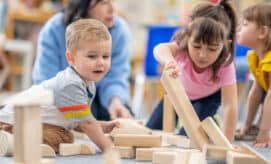Infants and toddlers express their desire to connect with each other in a variety of ways. As educators, we can be most supportive when we are able to recognize the signs that these youngest learners are seeking peer interaction.
In an article for NAEYC’s Young Children Magazine, ECE researcher, educator, and program director, Tracy Redman, explains that infants and toddlers attempt to initiate interactions with peers in a variety of ways:
- Trying to hug, kiss, or touch another child
- Smiling at another child or making sounds (such as cooing or babbling)
- Closely watching another child who is crying or expressing a big emotion
- Laughing at or with another child
- Taking turns with another child in a repetitive action (such as banging one item on another)
- Observing another child at play (demonstrating an awareness of the other child’s presence)
- Jumping, squealing, or falling down with another child.
When early education and care providers observe these infant and toddler behaviors, they can provide encouragement and support by acknowledging the child’s efforts. For example, you might say something like “Ryan, I notice you are watching Grace play with those blocks. I’m wondering if you are interested in playing with the blocks too.”
How Educators Can Nurture Early Friendships
In addition to acknowledging efforts to connect, educators and care providers can support early peer relationships by providing guidance and scaffolding to the infants and toddlers in their care. Below are some helpful tips for providing that early scaffolding.
Provide Collaborative Large Play Items
Large, open-ended items for play such as empty cardboard boxes, pillows, and cushions give children a fun opportunity to practice social interactions with their peers. For example, you might offer children a large cardboard box with some crayons for children to color, create, and explore. Through this experience, children will practice sharing and taking turns, as they work together to make room for peers to join in the activity together. They also will have a chance to practice problem-solving skills if conflicts arise while the children are all playing together.
Notice Teachable Moments
Relationship difficulties and conflicts can become teachable moments for infants and toddlers. An article from the American Academy of Pediatrics explains, “Even from the very start, children get very angry with friends. This gives you the opportunity to teach how to…express anger without verbally or physically hurting others.” In these moments we can support children by acknowledging their feelings and setting healthy boundaries that will help them communicate their experiences.
For example, if a disagreement emerges while two children are playing with the same toy, you might say something like, “I notice you’re getting frustrated about having to share that toy. It’s okay to be upset, but it’s not okay to hit each other. That hurts.” These interactions show children a way to practice regulating themselves so they can interact with their peers in a healthy way.
Consider Temperament
Each child is born with a different personality type or temperament. This means that certain activities and settings will be more comfortable for some children than others. Some children might enjoy dancing to loud music, while others might be overwhelmed by the noise and prefer a more quiet activity. As we support early relationship building, it is important to consider differences in personalities and preferences that might impact the types of play that a particular child finds comfortable.
For example, some children are slower to warm up, while others can jump right into a social interaction. For those who are slow to warm up, it is helpful to provide them with the space to feel safe and comfortable before initiating an interaction with a peer. Additionally, some children prefer high-activity play experiences, while others prefer something more quiet. Consider bringing a group of the higher-activity children out for play time together so that they can engage in more energetic activities while the other children enjoy something quieter, such as an art project.






